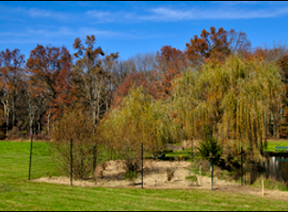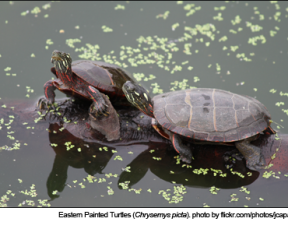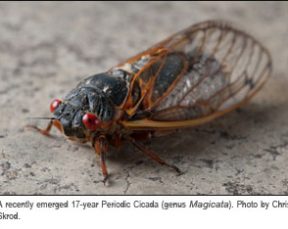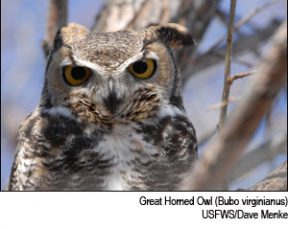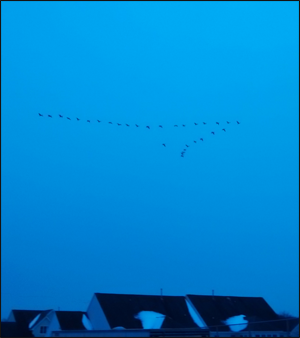

Geese in flight over NJ. Credit: Ann Campbell
The other day I was walking in a local parking lot, when I heard a persistent honking in the sky. It was getting louder and louder. When I looked skyward, I saw a flight of large birds — perhaps 50 or 75 of them, passing overhead. What was most striking was not their quantity, but that they were arranged in a loose “V” formation. “Ah, Canada geese,” I said to myself.
Later, I was thinking about the beauty of that formation of Canada geese. I wondered why we normally see them flying in a “V” formation, so I decided to do a little research. Let me share with you what I learned.
The Canada goose (Branta canadensis) species is native to North America. It breeds in Canada and in the northern United States in a variety of habitats. Annually, the geese migrate south from Canada and the Great Lakes region, for the winter. In the spring, they return north. These annual migrations require them to be able to fly great distances.
The flight in “V” formation has been studied by various researchers. It appears that birds take turns in the lead position of the “V,” since flying in front consumes the most energy. Meanwhile, all the other birds in formation will position themselves in spots that are aerodynamically optimal — spots where they can take advantage of the swirls of upward moving air generated by the wing beats of the bird ahead.
Those swirls are very important. As each goose flaps to generate lift, small “whirlpools” of air rise to the right and to the left of the animal. By following one another the right way and timing their wing beats perfectly, each goose can ride the “whirlpools” created by the animal immediately in front of it. The result is a reduction in the amount of energy each bird must expend to gain lift in flight. Unfortunately, the lead bird gets no such lift advantage! And, if one bird happens to get a little too close or a little too far from the bird it is following, it instantly adjusts its wing beats to compensate. The same re-adjustment occurs when a goose chooses to change its position within the “V.”
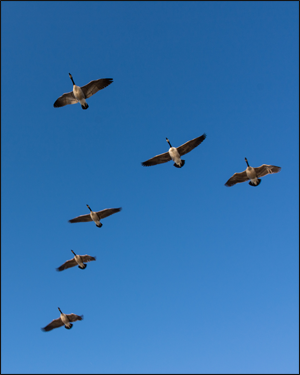

Formation of Canada Geese. Credit: Flickr.com/donjd2 (Don DeBold)
How do the birds know to fly in these optimal spots? Researchers say that geese may have evolved “rules of thumb” for flying, or that they have “good sensors” and merely adjust to find spots that feel good. The up-wash of air that helps each bird support its own weight in flight, follows the same principles glider aircraft use to climb or maintain height indefinitely in rising air. Whenever a goose falls out of formation, it suddenly feels the drag and resistance of trying to go it alone. Very quickly, it returns to the formation to take advantage of the lifting power supplied by the other birds.
Anecdotally, it is said that when a goose gets sick, or is wounded by gunshot, two other geese will fall out of the “V” formation, follow the injured bird to the ground, and protect it from further harm. The guardians stay put until the ailing bird is able to fly again, or until their compatriot is dead. Eventually, if the trio returns to the air, they launch out in their own formation or join another flock until they catch up with their own group. This entire scenario may be a myth, but it is a lovely thought.
Researchers apparently have not attempted to calculate the energy a bird might save by flying in a “V” formation, but estimates range from a 30% energy savings to a savings of more than 70%. On long migration flights, Canada geese typically fly at about 40 mph. These noisy groups honk their way along established paths that include designated “rest stops.” Being social birds, they remain in flocks year round, except while nesting.
Scientists do not know how geese in flight find the aerodynamic sweet spot, but they suspect that the birds align themselves either by sight or by sensing air currents through their feathers. Alternatively, they may move around until they find the location with the least resistance. Other questions wait for future research. For instance, how do the geese decide who sets the course and the pace? Can a mistake made by the lead goose ripple through the rest of the flock and cause traffic jams? Whatever future research may tell us, we know already that Canada geese are very effective, amazing birds.
